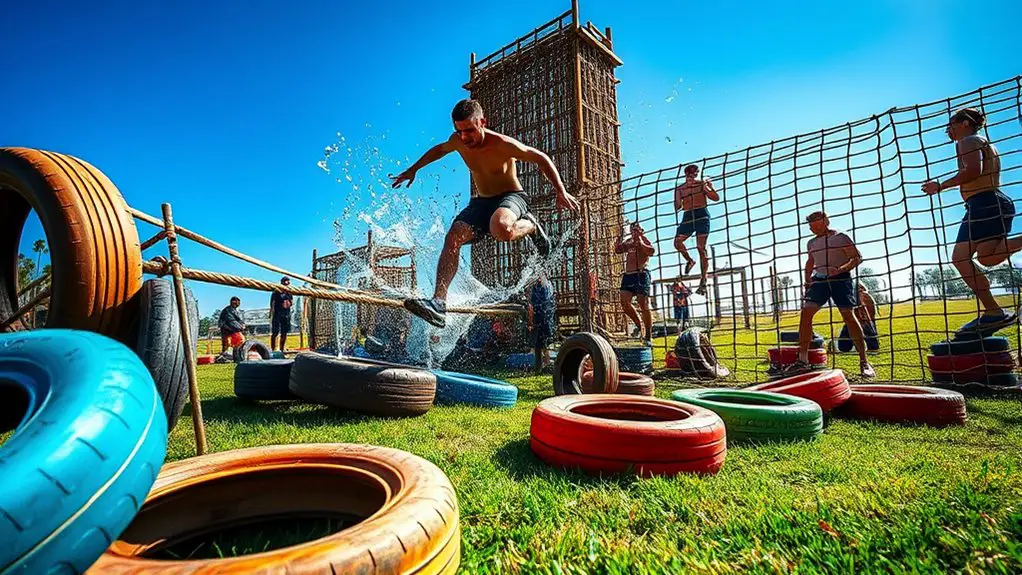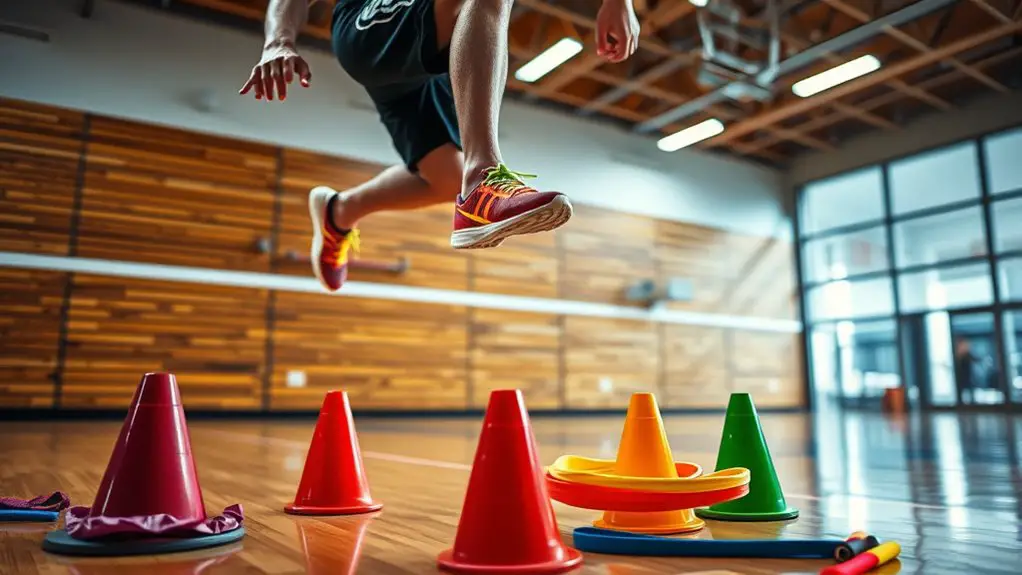The best obstacle course training methods combine strength, agility, and endurance. Focus on bodyweight exercises and compound movements to build functional strength. Incorporate agility drills like ladder work for better coordination. Long runs and interval training enhance endurance, while speed drills improve power. Don't forget to practice specific obstacles, like wall climbs and monkey bars, to boost your confidence. Integrating recovery strategies is essential too. To take your training to the next level, you've got more to discover!
Understanding Obstacle Course Racing
Obstacle course racing (OCR) has gained immense popularity in recent years, partly because it challenges both physical and mental endurance. If you're seeking an adventure that pushes your limits, OCR is the perfect avenue. You'll find yourself maneuvering through mud, walls, and ropes, all while testing your problem-solving skills under pressure. Each race offers a unique blend of obstacles, ensuring no two experiences are the same.
As you prepare for these races, you'll discover that it's not just about raw strength; it's about strategy and adaptability. You get to embrace the freedom of movement, choosing your approach to each challenge. Plus, the camaraderie among participants fosters a sense of community and support, making every finish line even more rewarding. Incorporating grip-strength training into your preparation will enhance your ability to tackle climbing and swinging obstacles effectively. So, lace up those shoes and get ready to release your potential in the exhilarating world of OCR, where freedom and challenge intertwine beautifully.
Building Functional Strength
When it comes to obstacle course training, building functional strength is key. Bodyweight exercises not only enhance your strength but also improve your overall mobility and coordination. Plus, focusing on core stability will help you tackle obstacles with greater efficiency and control. Additionally, incorporating bodyweight exercises into your routine can lead to improved balance and coordination, which are essential skills for navigating complex obstacle courses successfully.
Bodyweight Exercises Benefits
Bodyweight exercises are a powerful way to build functional strength, especially since they utilize your own body as resistance. They offer flexibility and freedom, allowing you to train anywhere without equipment. Here's a quick look at some key benefits:
| Benefit | Description |
|---|---|
| Improves Mobility | Enhances your range of motion |
| Builds Endurance | Increases stamina for challenges |
| Enhances Balance | Boosts your stability |
| Increases Flexibility | Promotes better movement patterns |
| Strengthens Core | Supports overall body function |
Incorporating bodyweight exercises into your routine can lead to greater overall fitness. You'll find you can tackle obstacles with ease, both physically and mentally, embracing the freedom that comes with being strong and capable.
Core Stability Importance
Core stability is essential for building functional strength, as it serves as the foundation for nearly all physical activities. When your core is strong, you'll find it easier to move freely and confidently, whether you're climbing, jumping, or maneuvering around obstacles. A stable core helps maintain balance and control, reducing the risk of injury while enhancing your overall performance. By focusing on exercises that engage your core, you're not just building strength in your abs; you're creating a solid base that supports your entire body. Think of it as your body's powerhouse, powering your every move. So, prioritize core stability in your training regime, and you'll gain greater freedom in your physical pursuits, allowing you to tackle even the toughest challenges with ease.
Enhancing Agility and Coordination
To enhance your agility and coordination, incorporating dynamic ladder drills and plyometric box exercises can make a big difference. These methods not only improve foot speed but also help you develop better body control. You'll find that mastering these drills can greatly boost your performance on obstacle courses. Additionally, strength training can further enhance your muscle power for directional changes, which is crucial for navigating obstacles effectively.
Dynamic Ladder Drills
Dynamic ladder drills are a fantastic way to boost your agility and coordination, essential skills for maneuvering any obstacle course. You'll find these drills not only fun but also liberating, allowing you to explore your movement potential. Start with basic footwork patterns, like the in-and-out or lateral shuffles, to get your body accustomed to quick changes. As you progress, challenge yourself with more complex sequences that keep you on your toes—literally! Incorporate different speeds and directions, and feel the freedom in your movement. The more you practice, the more fluid and confident you'll become, empowering you to tackle any obstacle with ease. So grab a ladder and release your agility—your adventure awaits!
Plyometric Box Exercises
If you've enjoyed the agility gains from dynamic ladder drills, plyometric box exercises will take your training to the next level. These exercises challenge your coordination and explosiveness, pushing your limits while keeping your workouts fresh and exciting. Start with basic jumps—spring onto the box and land softly. You can progress to lateral jumps or single-leg variations for added difficulty. As you gain confidence, increase the box height or the number of repetitions. These movements not only enhance your agility but also help you develop powerful muscles for obstacle courses. Plus, they'll make you feel free and nimble, ready to conquer any challenge that comes your way. Embrace the thrill of movement and watch your performance soar!
Developing Endurance for Long Races
As you prepare for long races, developing endurance becomes essential, especially when maneuvering challenging obstacle courses. To build that stamina, consider integrating these methods into your training routine:
- Long Runs: Embrace the open road or trail, letting your legs stretch and your mind wander as you clock in those miles.
- Interval Training: Alternate between high-intensity bursts and recovery periods, pushing your limits while still allowing your body to adapt.
- Hill Workouts: Conquer inclines to build strength and endurance, feeling the rush of freedom as you crest each peak.
- Cross-Training: Engage in activities like cycling or swimming, diversifying your workouts to keep things fresh and exciting. Incorporating high-intensity interval training can also significantly enhance your VO2 max, further boosting your endurance capabilities.
Incorporating Speed and Power Drills
Building endurance sets a strong foundation for tackling obstacle courses, but incorporating speed and power drills can take your performance to the next level. These drills help you develop explosive strength and quickness, essential for overcoming obstacles efficiently. Start with sprint intervals—alternate between short bursts of maximum effort and recovery periods. This boosts your speed while enhancing your cardiovascular fitness.
Next, focus on plyometric exercises like box jumps or burpees. They'll build your power, enabling you to leap over hurdles or climb walls with ease. Incorporating agility drills, such as ladder runs or cone drills, will sharpen your footwork, giving you the freedom to maneuver effortlessly. Additionally, engaging in plyometric exercises specifically targets fast-twitch muscle fibers, further enhancing your explosive capabilities.
Integrating these drills into your routine not only elevates your performance but also injects excitement into your training. Embrace the challenge, and you'll find yourself conquering those courses with newfound speed and power!
Practicing Specific Obstacles
While endurance and speed are crucial, practicing specific obstacles is essential for mastering the intricacies of an obstacle course. You want to feel confident and free as you navigate each challenge. Here are four key obstacles to focus on:
- Monkey Bars: Swing your body with grace, practicing the rhythm of your hands and feet to build upper body strength.
- Wall Climb: Find your footholds and push off with determination, mastering the technique to scale vertical heights effortlessly.
- Balance Beams: Channel your inner freedom by walking with precision, enhancing your core stability and focus.
- Rope Climb: Grip tight and pull yourself up, feeling the rush as you conquer gravity and gain confidence.
Recovery and Injury Prevention Strategies
To guarantee you're at your best on the obstacle course, focusing on recovery and injury prevention is just as important as the training itself. Your body's got to feel free and ready to tackle challenges, so take recovery seriously. Stretching after each session keeps your muscles flexible and reduces tightness. Incorporate foam rolling to release tension and improve circulation.
Listen to your body. If you feel pain, don't push through it—rest and allow time to heal. Hydration's essential, too; staying well-hydrated helps prevent cramps and keeps your energy up. Consider adding low-impact activities like swimming or yoga, which can enhance recovery without stressing your joints. Active recovery can also be beneficial, as it promotes movement while allowing your body to heal.
Lastly, don't underestimate the power of sleep. Quality rest is critical for muscle repair and overall performance. By integrating these recovery and injury prevention strategies, you'll keep your body free and ready to conquer every obstacle in your path.
Creating a Balanced Training Program
A balanced training program is essential for maximizing your performance on the obstacle course, as it guarantees you're developing strength, endurance, agility, and flexibility. To achieve this harmony, consider incorporating the following elements into your routine:
- Strength Training: Focus on compound movements like squats and deadlifts to build power for those challenging obstacles.
- Endurance Work: Include long runs or high-intensity interval training to enhance your stamina, allowing you to push through fatigue.
- Agility Drills: Use ladder drills or cone sprints to improve quickness and footwork, essential for maneuvering your way through courses.
- Flexibility Sessions: Incorporate yoga or dynamic stretching to maintain mobility and prevent injuries, ensuring your body moves freely. Additionally, prioritize core stability exercises, as they help strengthen stabilizing muscles to reduce injury risk during your training.
Frequently Asked Questions
What Equipment Is Essential for Obstacle Course Training?
For obstacle course training, you'll need essentials like sturdy shoes, resistance bands, a jump rope, cones for agility drills, and a pull-up bar. These tools'll help you improve strength, agility, and endurance effectively.
How Often Should I Train for Obstacle Course Races?
You should train at least three to four times a week for obstacle course races. Consistency builds strength and endurance, but listen to your body—rest days are just as important for recovery and performance.
Can I Train for Obstacle Courses at Home?
Imagine your living room as a jungle gym; you can definitely train for obstacle courses at home. With creativity, furniture becomes hurdles, and everyday items transform into tools, giving you the freedom to conquer your challenges.
What Nutrition Should I Follow While Training?
While training, focus on whole foods—lean proteins, healthy fats, and plenty of fruits and veggies. Don't forget to stay hydrated and listen to your body's needs. You'll feel more energized and ready to tackle challenges!
How Do I Mentally Prepare for an Obstacle Course Race?
To conquer your mind's mountain, visualize success and embrace the thrill. Focus on your strengths, breathe deeply, and trust your training. Remember, each challenge is a step toward freedom; you've got this!




